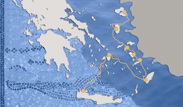The early christian basilica of Kardamena
The site of Ancient Halassarna
is located in the modern village
of Kardamena on the south
coast of Kos, approximately 30 kilometres
southwest of the capital city. Neolithic, geometric and classical remains unearthed
in systematic excavations by the University
of Athens over the past
30 years reveal the continuity of settlement in the ancient city, which
flourished in Hellenistic times and retained its vitality throughout the Roman
and early Christian periods. Combined with rich finds, the settlement, the
cemetery and four Early Christian basilicas reveal a thriving city with
workshops, small industry installations and significant commercial activity.
The Basilica of the Holy
Godhead was identified and excavated by German archaeologist Rudolf Herzog in
the early 20th century. It is a three-aisled basilica of impressive
dimensions (60m in length) with a narthex
of impressive
dimensions (60m in length) with a narthex , an atrium
, an atrium and a
three-sided sanctuary apse.
The church floors are meticulously decorated with mosaics, and ancient
materials (marble architectural members and inscribed columns) are incorporated
into the walls. The monument was built in the 5th century.
and a
three-sided sanctuary apse.
The church floors are meticulously decorated with mosaics, and ancient
materials (marble architectural members and inscribed columns) are incorporated
into the walls. The monument was built in the 5th century.
A second important basilica was recently discovered in the centre of the modern village of Kardamena.
According to inscriptions, the founders were Dorotheus, Eutychius and Photeinos the Senior. Measuring
27 by 14 metres, it was erected around 500 and remained in use until the
mid-7th century. This church is also a three-nave basilica
was recently discovered in the centre of the modern village of Kardamena.
According to inscriptions, the founders were Dorotheus, Eutychius and Photeinos the Senior. Measuring
27 by 14 metres, it was erected around 500 and remained in use until the
mid-7th century. This church is also a three-nave basilica with narthex
with narthex .
The impressive picture afforded by the excavated ruins clearly shows the
building’s basic features, such as a protruding central sanctuary apse; a
rectangular atrium surrounded by galleries on three sides; a wing with six
annexes along the north side of the church; and a rectangular baptistery with
an apse and two baptismal fonts to the south-east, which is the only one of its
kind on Kos. The floor mosaics were the product of a local workshop, and are
mainly decorated in geometric patterns, featuring wheels, octagons, squares and
crosses, with a few non-geometric bird and plant motifs.
.
The impressive picture afforded by the excavated ruins clearly shows the
building’s basic features, such as a protruding central sanctuary apse; a
rectangular atrium surrounded by galleries on three sides; a wing with six
annexes along the north side of the church; and a rectangular baptistery with
an apse and two baptismal fonts to the south-east, which is the only one of its
kind on Kos. The floor mosaics were the product of a local workshop, and are
mainly decorated in geometric patterns, featuring wheels, octagons, squares and
crosses, with a few non-geometric bird and plant motifs.
Bibliography (6)▼
Comments (0)▼
New Comment▼







